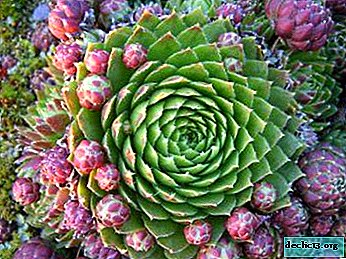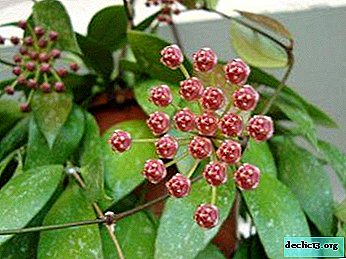Features of caring for indoor plants during the flowering period: how to care for the arrow of an orchid?

The abundance of flowers of an unpretentious form, with bright colors, collected in inflorescences makes the orchid in demand in decorative floriculture. You can watch this miracle of nature without ceasing. But the most beautiful period is flowering, we look forward to it, and we are trying to extend it by all possible means. This article describes in detail the features of caring for indoor plants during the flowering period and tells how to properly care for the arrow of an orchid.
Peduncle of a plant
The arrow, which was launched by the orchid and on which the buds appear, is commonly called the peduncle. This part of the stem, as a rule, appears from a growth point (more about that such a growth point, why it is needed, and also what are the reasons for its absence, we told here). The flower process consists of sleeping and flower buds. From flower buds, respectively, buds appear, dormant ones remain at rest until flowering ends. From sleeping buds, a lateral peduncle or baby may appear.
The arrow of a flower usually has a bright green appearance along its entire length and grows differently. The peduncle can bend, in the form of a pigtail, and then tend to vertically upward. It can also deviate in any direction. It is in the process of growth that the flowering process cannot be touched and, especially, transplanted.
The most popular flowering orchid varieties are Phalaenopsis and Cymbidium.. The latter is famous for a long arrow with large inflorescences, which is often used for cutting. But, for example, in the Dendrobiums, the bulb plays the role of a peduncle (for details on what a bulb and a pseudobulb are, and also what are the differences from true to false, read here).
.
Photo
Check out how the orchid releases the arrow, the process is presented in the photo with the description, and also see how the root of the flower looks:





What is the difference from aerial root?
Inexperienced gardeners often confuse an orchid arrow with aerial roots or a root baby. The location of the peduncle is more predictable, in contrast to the roots. The flower-bearing process appears from the sinus of leaves, that is, the place where the leaf is in contact with the stem. He breaks through the leaf, and strive up. The peduncle has a sharp tip, similar to a beak. In length it is covered with small scales, a green tint.
Also, the arrow of an orchid is called a stem. Although in fact, these are two different parts of the plant. Buds are attached to the peduncle, and leaves are attached to the stem.
What role does it play?
An arrow plays an important role in the life cycle of an orchid. Under favorable growing conditions, it reaches a height of 80-100 cm. And carry up to 80 flowers. With the advent of the peduncle, the flowering process begins: buds are formed, which subsequently grow, develop, blossom. The flower stalk is involved in the development of inflorescences, nourishes them with moisture, nutrients. The duration of the flowering stage reaches an average of 3 months.
The second function is reproductive. On the flower-bearing process, children are most often formed - miniature copies of the flower itself. They germinate at the end of flowering, and rests on the peduncle until complete formation. The child’s code appeared 3-4 roots and a couple of leaves, it is cut off for independent growth.
How does a plant throw an arrow?
Peduncle pecks at the bottom of the stem, under the leaf. Although there are chaotic locations. The appearance of a new arrow occurs under the influence of certain factors: temperature, humidity, lighting, watering. Under adverse conditions, the formation of a peduncle will not be possible.
Reference! The flowering process usually begins in the fall, when during the summer the orchid gained strength and gained strength. And in winter there comes a period of rest. However, different varieties have different life cycles.What if this happened?
Duration of growth of the peduncle: from the appearance to the opening of the first flowers, it takes about 2-3 months. The time it depends on the amount of sunlight. Respectively the longer the lighting, the sooner flowering occurs.
In the period of active boom growth, it is worth paying attention to three main parameters:
 Choose the most lighted place in the house. In autumn, a pot with a plant can be placed on the windowsill on the south side, they are not afraid of intense sunlight. On the other hand, during this period, daylight hours are significantly reduced, and if the peduncle has not begun to form buds, it should be illuminated. Orchids need an additional light source so that the daylight hours are at least 12 hours.
Choose the most lighted place in the house. In autumn, a pot with a plant can be placed on the windowsill on the south side, they are not afraid of intense sunlight. On the other hand, during this period, daylight hours are significantly reduced, and if the peduncle has not begun to form buds, it should be illuminated. Orchids need an additional light source so that the daylight hours are at least 12 hours.- Watering. Provide good hydration, do not overfill, but do not bring to dryness. Monitor the condition of the substrate in the pot. Use water exclusively at warm or room temperature. It is important that it be purified without salt impurities, soft.
- Apply fertilizer before and during flowering. With the growth of the peduncle, you can feed the plant with minerals with a high content of potassium and phosphorus. It is these substances that actively affect the number of future inflorescences, as well as the quality of flowering.
What if there are no shoots?
Why does this happen? A number of factors affect the quality and frequency of inflorescence formation.
- Low humidity. High air temperature and low humidity are dangerous parameters for the life of the plant. Moisture rather quickly evaporates through the leaves, and the roots do not have time to nourish in time. Humidity should correspond to temperature, with increasing temperature, humidity increases, and vice versa. The maximum humidity level is 30-40%.
- Orchid does not bloom and does not shoot if not enough sunlight. Improper placement of the pot plays a direct role. It is especially critical during the formation of a stele or buds. Flowers prefer bright but not scorching lighting, as well as daylight hours of 10-12 hours. Without light, the tip of the orchid begins to dry, its development as a whole slows down.
- Difficulties with the root system. Roots are an important organ in the life cycle of orchids. They take part in the process of photosynthesis. If there are problems with the roots, accordingly, this is negatively displayed on the general condition of the plant, in particular on the development of the peduncle. Read about how healthy flower roots look and what problems may arise with them, read here.
- Temperature. The temperature regime is important for the appearance of the peduncle. Orchid is mostly heat-loving plants, respectively, the temperature in the room should be maintained at + 25-27 ° C. To stimulate flowering, stress can be made. Arrange temperature differences between day and night by 5-10 ° C.
When normalizing the above parameters, the orchid will release the long-awaited peduncle.
When the new shoot broke
 If the flower stalk of a young plant is broken, it has not yet bloomed, then there is no big trouble in this. It is enough to cut the peduncle before the appearance of a sleeping kidney (how to wake sleeping buds near an orchid can be found here).
If the flower stalk of a young plant is broken, it has not yet bloomed, then there is no big trouble in this. It is enough to cut the peduncle before the appearance of a sleeping kidney (how to wake sleeping buds near an orchid can be found here).
- Using a garden pruner or sharp knife, we make a cut below the level of the kidneys.
- Sprinkle a live slice with an antiseptic.
- Do not water the flower for 7-10 days, let it recover.
A trimmed flower-bearing process to process stimulants for the roots and put in a container of water. Therefore, multiply. And after some time, the plant will release a new process.
Important! In order to prevent, the peduncle should be supported with a plastic support. And also put the pot in a place where it is minimally threatened with mechanical damage.Watch a video on what you need to do when the orchid flower stalk has broken:
Possible problems
As it turned out, peduncle may dry out or fade. And the reasons for this are not only natural processes, but also under the influence of a number of factors.
- improper lighting;
- overabundance or malnutrition;
- problems with the root system;
- air humidity;
- mechanical damage;
- infectious diseases and pests;
- excessive watering;
- stress.
Care Features
In order for the orchid to give an arrow and delight with its unsurpassed flowering, it is necessary to optimize the conditions and know how to care for it. The plant should have enough forces to expel the arrow, the formation of buds and direct flowering. To do this:
 Maintain indoor temperature in summer: + 22-25ºС, in winter + 16-18ºС.
Maintain indoor temperature in summer: + 22-25ºС, in winter + 16-18ºС.- The pot should be placed in the sun, but scorching rays should be shaded.
- Maintain humidity between 50-60% with a household humidifier.
- Regularly arrange the ventilation of the room.
- Water once a week, in between the soil should completely dry. Spray the flower every day. Use warm and purified water.
- Fertilize orchids with fertilizers and potassium and phosphorus.
Watch a video about the features of orchid care to stimulate flowering:
The appearance of a flower arrow is undoubtedly a joy for the owner. It is important to follow all the rules, especially the care, so that the flowering is lush and long. An orchid that shoots an arrow needs special care. Do not neglect this and the plant will certainly appreciate.

 Choose the most lighted place in the house. In autumn, a pot with a plant can be placed on the windowsill on the south side, they are not afraid of intense sunlight. On the other hand, during this period, daylight hours are significantly reduced, and if the peduncle has not begun to form buds, it should be illuminated. Orchids need an additional light source so that the daylight hours are at least 12 hours.
Choose the most lighted place in the house. In autumn, a pot with a plant can be placed on the windowsill on the south side, they are not afraid of intense sunlight. On the other hand, during this period, daylight hours are significantly reduced, and if the peduncle has not begun to form buds, it should be illuminated. Orchids need an additional light source so that the daylight hours are at least 12 hours. Maintain indoor temperature in summer: + 22-25ºС, in winter + 16-18ºС.
Maintain indoor temperature in summer: + 22-25ºС, in winter + 16-18ºС.















